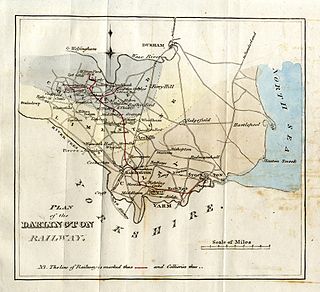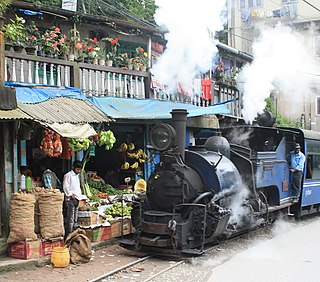
The Settle–Carlisle line is a 73-mile-long (117 km) main railway line in northern England. The route, which crosses the remote, scenic regions of the Yorkshire Dales and the North Pennines, runs between Settle Junction, on the Leeds–Morecambe line, and Carlisle, near the English-Scottish borders. The historic line was constructed in the 1870s and has several notable tunnels and viaducts such as the imposing Ribblehead.

The London and North Eastern Railway (LNER) was the second largest of the "Big Four" railway companies created by the Railways Act 1921 in Britain. It operated from 1 January 1923 until nationalisation on 1 January 1948. At that time, it was divided into the new British Railways' Eastern Region, North Eastern Region, and partially the Scottish Region.

The Stockton and Darlington Railway (S&DR) was a railway company that operated in north-east England from 1825 to 1863. The world's first public railway to use steam locomotives, its first line connected collieries near Shildon with Darlington and Stockton in County Durham, and was officially opened on 27 September 1825. The movement of coal to ships rapidly became a lucrative business, and the line was soon extended to a new port at Middlesbrough. While coal waggons were hauled by steam locomotives from the start, passengers were carried in coaches drawn by horses until carriages hauled by steam locomotives were introduced in 1833.

A cowcatcher, also known as a pilot, is the device mounted at the front of a locomotive to deflect obstacles on the track that might otherwise damage or derail it or the train.

The Darjeeling Himalayan Railway, also known as the DHR or the Toy Train, is a 610 mm gauge railway that runs between New Jalpaiguri and Darjeeling in the Indian state of West Bengal. Built between 1879 and 1881, it is about 88 km (55 mi) long. It climbs from about 100 m (330 ft) above sea level at New Jalpaiguri to about 2,200 m (7,200 ft) at Darjeeling, using six zig zags and three loops to gain altitude. Ghum station is situated at an altitude of 2,258 metres (7,407 ft). Six diesel locomotives handle most of the scheduled service, with daily tourist trains from Darjeeling to Ghum – India's highest railway station – and the steam-hauled Red Panda service from Darjeeling to Kurseong. Steam-enthusiast specials are hauled by vintage British-built B-Class steam locomotives. The railway's headquarters are at Kurseong.

The Blue Pullmans were luxury trains used from 1960 to 1973 by British Rail. They were the first Pullman diesel multiple units, incorporating several novel features.

The Bowes Railway, built by George Stephenson in 1826, is the world's only operational preserved standard gauge cable railway system. It was built to transport coal from pits in Durham to boats on the River Tyne. The site is a scheduled monument. The railway is open every week on Thursday, Friday and Saturday as well as on a number of event days throughout the year.

The BR Standard Class 2 2-6-0 is a class of steam locomotive, one of the British Railways Standard classes of the 1950s. They were physically the smallest of the Standard classes; 65 were built.
British Transport Films was an organisation set up in 1949 to make documentary films on the general subject of British transport. Its work included internal training films, travelogues, and "industrial films" promoting the progress of Britain's railway network.

Elizabethan Express is a 1954 British Transport Film that follows The Elizabethan, a non-stop British Railways service from London King's Cross to Edinburgh Waverley along the East Coast Main Line. Although originally intended as an advertising short, it now acts as a nostalgic record of the halcyon years of steam on British Railways and the ex LNER Class A4.

LNER Peppercorn Class A1 No. 60163 Tornado is a 4-6-2 steam locomotive completed in 2008 to an original design by Arthur Peppercorn. It is the first new build British mainline steam locomotive since 1960, and the only Peppercorn Class A1 in existence after the original batch were scrapped. In 2017, Tornado became the first steam locomotive to officially reach 100 mph (160 km/h) on British tracks in over 50 years.

Gateshead TMD was a railway traction maintenance depot situated in Gateshead, England. The depot code was 52A during the steam era and GD later on.

The South Durham and Lancashire Union Railway (SD&LUR) built a railway line linking the Stockton and Darlington Railway near Bishop Auckland with the Lancaster and Carlisle Railway at Tebay, via Barnard Castle, Stainmore Summit and Kirkby Stephen. The line opened in 1861 and became known as the Stainmore Line.
Kirkby Stephen East railway station was situated on the South Durham & Lancashire Union Railway between Barnard Castle and Tebay. It served the town of Kirkby Stephen in England and was a junction station for the Eden Valley Railway.

Barras railway station was situated on the South Durham & Lancashire Union Railway between Barnard Castle and Kirkby Stephen East.

The NER 901 Class was a class of 2-4-0 steam locomotive of the North Eastern Railway, designed by Edward Fletcher. Between 1872 and 1882 55 of the class were built for the NER.

The Race to the North is an episode of Top Gear that featured a three-way race held in 2009 between a Jaguar XK120 car, a Vincent Black Shadow motorcycle, and railway locomotive 60163 Tornado – a brand new mainline steam engine completed in Britain in 2008. The race saw the car, bike and locomotive, race from London, England, to Edinburgh, Scotland, a journey of around 400 miles (640 km). Eighteen months in the planning, the race was filmed in secret on 25 April 2009, and shown on 21 June 2009 as the first episode of the thirteenth series of Top Gear

Snow is a short documentary film made by Geoffrey Jones for British Transport Films in 1962–1963.

The Furka Steam Railway is a largely volunteer-operated heritage railway which operates a partially rack and pinion-operated line across the Furka Pass, between Realp in Uri and Oberwald in Valais. Culminating at 2,160 metres (7,087 ft), above sea level, it is an old mountainous section of the Furka Oberalp Bahn (FO) that was abandoned after the construction of the Furka Tunnel. It has been gradually brought back into service by the Verein Furka-Bergstrecke with the use of only steam locomotives, with the entire line completed in 2010. As a result, the nearly 18 kilometre-long Furka Railway is the longest operated unelectrified line in Switzerland. It is also the second highest rail crossing in Europe, after the Bernina Railway. The Uri side of the line also constitutes the highest railway in Central Switzerland.

The GNR Classes D2 and D3 were two classes of 51 4-4-0 steam locomotives designed by Henry Ivatt for the Great Northern Railway (GNR). They were the first 4-4-0s to be introduced by the GNR, and Ivatt's first original design for the railway as well.


















